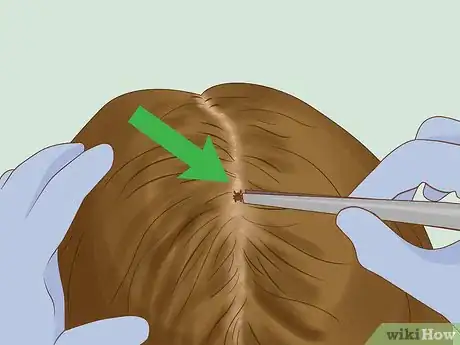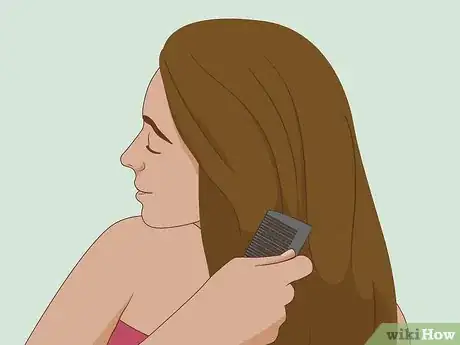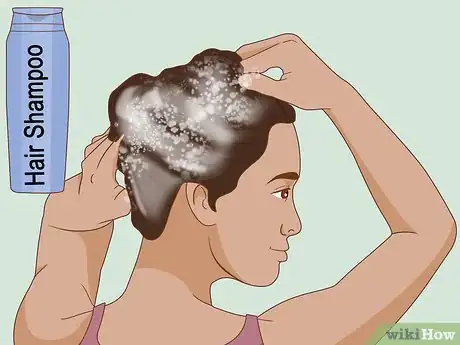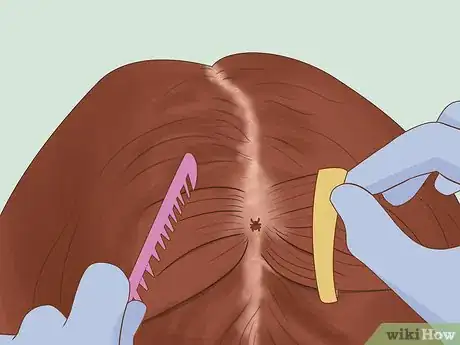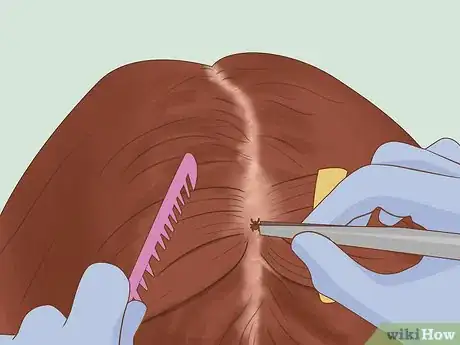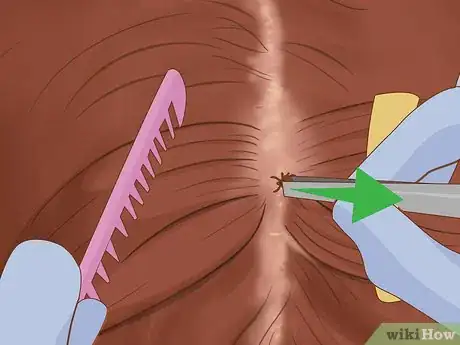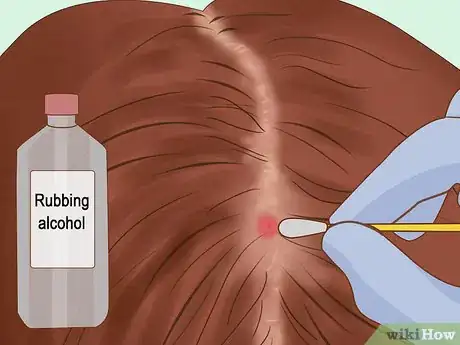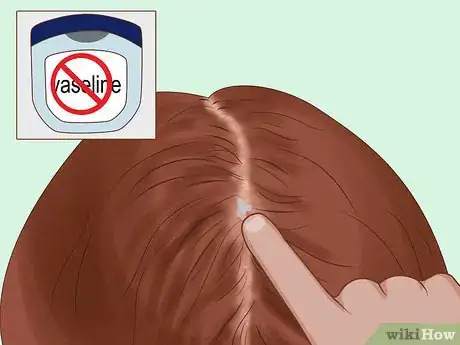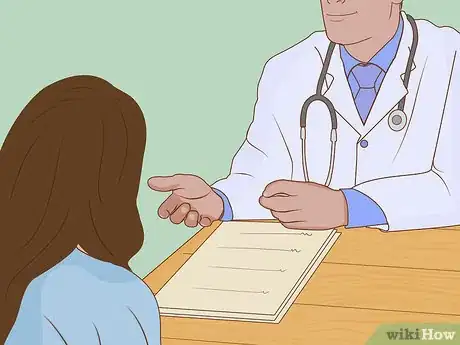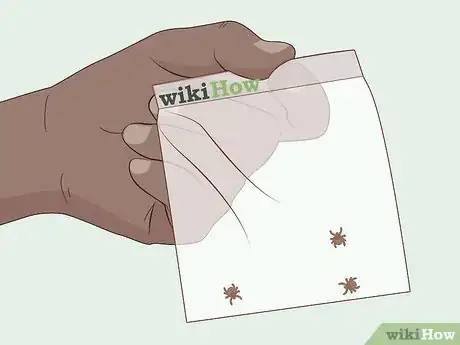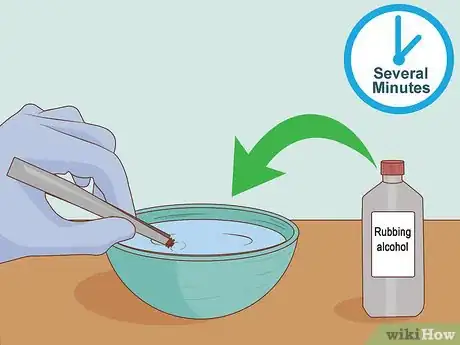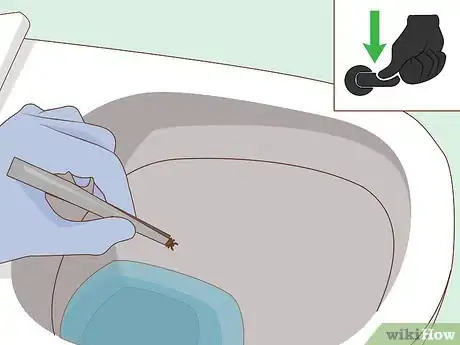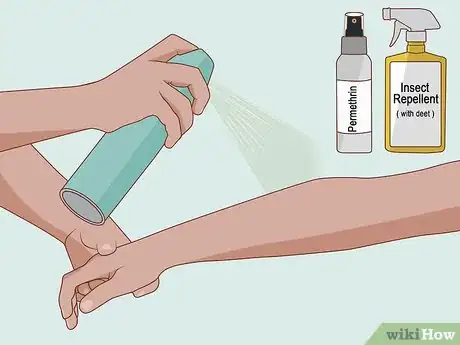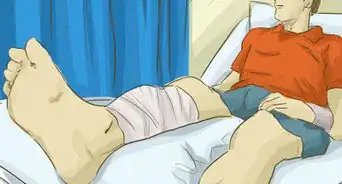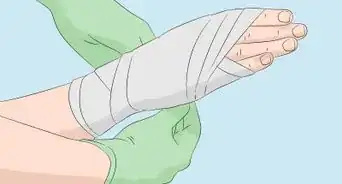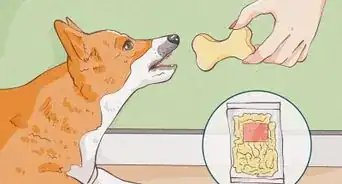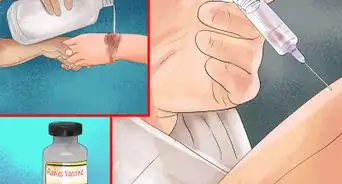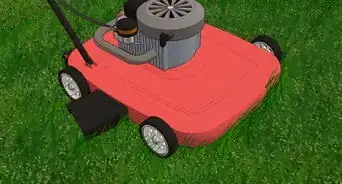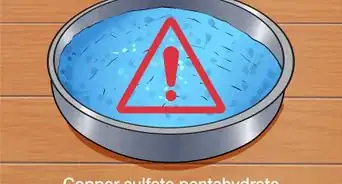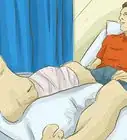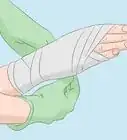This article was co-authored by Josh Goldbach. Josh Goldbach is an Outdoor Education Expert and the Executive Director of Bold Earth Adventures. Bold Earth leads adventure travel camps for teenagers all over the world. With almost 15 years of experience, Josh specializes in outdoor adventure trips for teens both in the United States and internationally. Josh earned his B.A. in Psychology from Eckerd College in St. Petersburg, Florida. He’s also trained as a wilderness first responder, a Leave No Trace master educator, and a Level 5 Swiftwater rescue technician.
There are 10 references cited in this article, which can be found at the bottom of the page.
This article has been viewed 134,547 times.
Hiking, biking, and other outdoor activities might be a fun way to spend the summer, but they can also invite ticks. If a tick has fallen into your hair or attached to your scalp, you should quickly remove it with a comb, tweezers, and disinfectant. You can keep the tick if you want to test it for disease. Otherwise, you should dispose of the tick to keep it out of your hair for good.
Steps
Clearing out Unattached Ticks
-
1Ask someone to check your scalp. Make sure that they put on gloves before they start. Ask them to check all areas of your head and scalp. Ticks can be quite small, so the person should look for tiny brown or black flecks on your skin.[1]
- If they see any unattached ticks, they should pick them up with gloved fingers, a piece of tissue, or tweezers.
- It will be easiest if you have a partner remove the tick from your hair for you, but if you are doing it yourself, use a mirror to help you see your scalp.
-
2Comb through your hair. Using a fine-toothed comb, brush your hair to loosen any ticks that might be hiding. If any ticks fall off or become stuck in your comb, kill them by putting them in a cup of rubbing alcohol.[2]Advertisement
-
3Wash your hair. Within two hours of coming inside, take a shower, and wash your hair with normal shampoo. This can help rinse away ticks before they have a chance to attach.[3] Doing this soon after you come home will reduce the chance that the ticks will burrow into your skin.
Removing Attached Ticks
-
1Part your hair. You may need to pull your hair away from the tick so that you can reach it. Use a comb or a toothbrush to move aside the hair. Be careful not to touch the tick. Secure the hair away from the tick with a clip.
-
2Grasp the tick with tweezers. Get the head of the tweezers as close as possible to the surface of the skin. If the tick is swollen, avoid grabbing it by the stomach. It may release fluids into your body that can cause disease.[4]
- Many tools are sold that are designed for tick removal. You can use one of these instead of tweezers. The process of pulling out the tick will be the same.
- If you do not have tweezers, you can use gloved fingers or tissue paper, but this is a more difficult method. Be careful not to squeeze or crush the tick.
-
3Pull the tick straight out. Avoid twisting or yanking the tick out, or the tick might break, leaving parts of their mouth inside of your body. Instead, use a steady hand to pull the tick straight out from the skin.[5]
-
4Dab the site with disinfectant to kill germs. Dip a cotton swab into rubbing alcohol, iodine, antiseptic cream, or another disinfectant. Gently apply it around the area of the tick bite. Wash your hands when you are done.[6]
-
5Avoid smothering or burning the tick. Do not try to smother a tick by putting nail polish or petroleum jelly (like Vaseline) on it while it is still attached. Furthermore, burning the tick may injure you without removing the tick. These methods can cause the tick to burrow deeper into your skin or to release diseased fluids into your body.[7]
-
6Visit a doctor if you cannot remove the tick. If you are struggling to remove the tick, see a doctor immediately to do it for you. For two weeks after tick removal, visit the doctor if you have any signs of illness, such as rash, fever, joint pain, or swelling of the bite.[8]
- Ticks can carry various diseases, such as Lyme disease, Colorado tick fever, or Rocky Mountain spotted fever.
Disposing of the Tick
-
1Put the tick in a secure container if you want to test it for disease. You can use a jar, ziplock bag, or any sealed container. If you develop symptoms within two weeks of the bite, take the jar with you to the doctor. The doctor can send the tick out for testing.[9]
- If you want to save a tick for testing, do not squash it, burn it, or put it in alcohol. Simply put it in the container, and leave it until you are ready to test it.
- Medical testing can be expensive. Even if the tick carries a disease, it does not mean that you have been infected.
-
2Tape the tick if you want to identify its species. Attach the tick onto a piece of paper with a sturdy piece of transparent tape, like packing tape. This will keep it contained until you can identify what type of tick it is. Different species are likely to carry certain diseases. If you become sick, this information can help your doctor make a diagnosis.[10]
- You can bring it to the doctor or you can look up different species of ticks online to identify it yourself.
- Black-legged ticks are more likely to carry Lyme disease while lone star ticks and dog ticks can give you Rocky Mountain spotted fever.[11]
-
3Drown the tick in alcohol to kill it. If you do not want to save the tick, kill it with alcohol. Fill a cup or bowl with rubbing alcohol, and dunk the tick inside. Leave it for several minutes. This will likely kill the tick.[12]
-
4Flush the tick down the toilet to get rid of it permanently. Just to be safe, you should avoid throwing out a tick in the trash. Instead, wrap it in a piece of toilet paper, and flush it down the toilet. This will ensure that the tick is safely out of your home.[13]
-
5Use caution when you go outside to avoid ticks. Next time you go outside, try to prevent ticks from latching onto you. There are many things you can do to reduce your chance of a tick bite.[14]
- Apply an insect repellent containing DEET. If you have children, spray the repellent on for them.
- Use permethrin on all of your clothing and gear. This is usually available at outdoor stores.
- Check everyone for ticks after coming inside. Pay special attention to their arms, knees, waist, belly button, ears, and hair. Remember to check pets as well!
- After coming inside, put your clothes in the dryer on high heat for an hour to kill any ticks that might be hiding in your clothing.[15]
- Light-colored clothing will let you see ticks more easily. Wear long-sleeved shirts, long pants, and boots if possible. Tuck these into one another.[16]
Community Q&A
-
QuestionHow do you check heavy hair for ticks?
 Community AnswerTry using a flea comb and, if you see a tick, then you can use lice treatment from local pharmacies or, try to use home remedies if you prefer. If you have difficulty checking your own hair, have someone you trust do this for you; this is probably best for thick hair as you have various layers to check beneath.
Community AnswerTry using a flea comb and, if you see a tick, then you can use lice treatment from local pharmacies or, try to use home remedies if you prefer. If you have difficulty checking your own hair, have someone you trust do this for you; this is probably best for thick hair as you have various layers to check beneath.
Warnings
- Never crush or squash a tick with your fingers, especially a bloated tick. They may release fluids that can cause disease.⧼thumbs_response⧽
References
- ↑ https://medlineplus.gov/ency/article/007211.htm
- ↑ https://www.healthlinkbc.ca/health-topics/tp23585spec
- ↑ https://www.cdc.gov/features/stopticks/index.html
- ↑ https://www.healthlinkbc.ca/health-topics/tp23585spec
- ↑ https://www.cdc.gov/ticks/removing_a_tick.html
- ↑ https://www.cdc.gov/ticks/removing_a_tick.html
- ↑ https://www.healthlinkbc.ca/health-topics/tp23585spec
- ↑ https://www.healthlinkbc.ca/health-topics/tp23585spec
- ↑ https://medlineplus.gov/ency/article/007211.htm
- ↑ https://www.cdc.gov/lyme/removal/
- ↑ http://www.michigan.gov/documents/emergingdiseases/5commonticks_282020_7.pdf
- ↑ https://www.cdc.gov/ticks/removing_a_tick.html
- ↑ http://www.aafp.org/afp/2002/0815/p646.html
- ↑ https://www.cdc.gov/features/stopticks/index.html
- ↑ https://www.healthlinkbc.ca/health-topics/tp23585spec
- ↑ https://www.epa.gov/insect-repellents/tips-prevent-tick-bites
About This Article
After spending time outside, comb out your hair or take a shower as soon as you can to prevent any unattached ticks from attaching to your scalp. If you see an unattached tick in your hair, pick it up with gloved fingers, a piece of tissue, or tweezers. However, if the tick has already attached to your scalp, part your hair to get a better view, then grasp the tick with tweezers as close as possible to your skin’s surface. When getting the tick off, pull it straight out from the skin so you remove all of it at once. After you remove the tick, dab the site with rubbing alcohol to disinfect it. To learn how to get a tick tested for diseases, keep reading!
